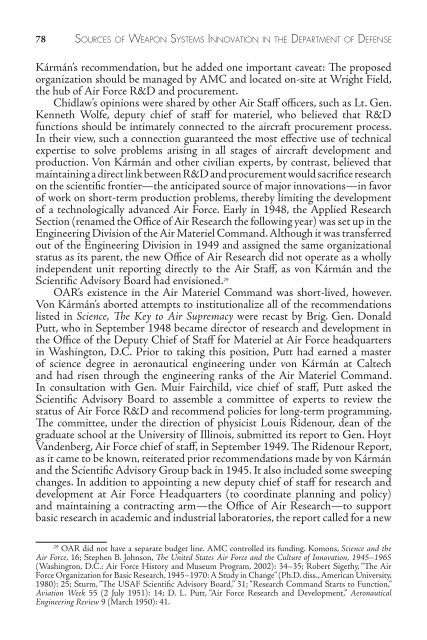To download as a PDF click here - US Army Center Of Military History
To download as a PDF click here - US Army Center Of Military History
To download as a PDF click here - US Army Center Of Military History
You also want an ePaper? Increase the reach of your titles
YUMPU automatically turns print PDFs into web optimized ePapers that Google loves.
78 so u R c e s o f we a p o n sy s T e m s In n o v a T Io n In T h e depaR TmenT o f defense<br />
Kármán’s recommendation, but he added one important caveat: The proposed<br />
organization should be managed by AMC and located on-site at Wright Field,<br />
the hub of Air Force R&D and procurement.<br />
Chidlaw’s opinions were shared by other Air Staff officers, such <strong>as</strong> Lt. Gen.<br />
Kenneth Wolfe, deputy chief of staff for materiel, who believed that R&D<br />
functions should be intimately connected to the aircraft procurement process.<br />
In their view, such a connection guaranteed the most effective use of technical<br />
expertise to solve problems arising in all stages of aircraft development and<br />
production. Von Kármán and other civilian experts, by contr<strong>as</strong>t, believed that<br />
maintaining a direct link between R&D and procurement would sacrifice research<br />
on the scientific frontier—the anticipated source of major innovations—in favor<br />
of work on short-term production problems, t<strong>here</strong>by limiting the development<br />
of a technologically advanced Air Force. Early in 1948, the Applied Research<br />
Section (renamed the <strong>Of</strong>fice of Air Research the following year) w<strong>as</strong> set up in the<br />
Engineering Division of the Air Materiel Command. Although it w<strong>as</strong> transferred<br />
out of the Engineering Division in 1949 and <strong>as</strong>signed the same organizational<br />
status <strong>as</strong> its parent, the new <strong>Of</strong>fice of Air Research did not operate <strong>as</strong> a wholly<br />
independent unit reporting directly to the Air Staff, <strong>as</strong> von Kármán and the<br />
Scientific Advisory Board had envisioned. 29<br />
OAR’s existence in the Air Materiel Command w<strong>as</strong> short-lived, however.<br />
Von Kármán’s aborted attempts to institutionalize all of the recommendations<br />
listed in Science, The Key to Air Supremacy were rec<strong>as</strong>t by Brig. Gen. Donald<br />
Putt, who in September 1948 became director of research and development in<br />
the <strong>Of</strong>fice of the Deputy Chief of Staff for Materiel at Air Force headquarters<br />
in W<strong>as</strong>hington, D.C. Prior to taking this position, Putt had earned a m<strong>as</strong>ter<br />
of science degree in aeronautical engineering under von Kármán at Caltech<br />
and had risen through the engineering ranks of the Air Materiel Command.<br />
In consultation with Gen. Muir Fairchild, vice chief of staff, Putt <strong>as</strong>ked the<br />
Scientific Advisory Board to <strong>as</strong>semble a committee of experts to review the<br />
status of Air Force R&D and recommend policies for long-term programming.<br />
The committee, under the direction of physicist Louis Ridenour, dean of the<br />
graduate school at the University of Illinois, submitted its report to Gen. Hoyt<br />
Vandenberg, Air Force chief of staff, in September 1949. The Ridenour Report,<br />
<strong>as</strong> it came to be known, reiterated prior recommendations made by von Kármán<br />
and the Scientific Advisory Group back in 1945. It also included some sweeping<br />
changes. In addition to appointing a new deputy chief of staff for research and<br />
development at Air Force Headquarters (to coordinate planning and policy)<br />
and maintaining a contracting arm—the <strong>Of</strong>fice of Air Research—to support<br />
b<strong>as</strong>ic research in academic and industrial laboratories, the report called for a new<br />
29 OAR did not have a separate budget line. AMC controlled its funding. Komons, Science and the<br />
Air Force, 16; Stephen B. Johnson, The United States Air Force and the Culture of Innovation, 1945–1965<br />
(W<strong>as</strong>hington, D.C.: Air Force <strong>History</strong> and Museum Program, 2002): 34–35; Robert Sigethy, “The Air<br />
Force Organization for B<strong>as</strong>ic Research, 1945–1970: A Study in Change” (Ph.D. diss., American University,<br />
1980): 25; Sturm, “The <strong>US</strong>AF Scientific Advisory Board,” 31; “Research Command Starts to Function,”<br />
Aviation Week 55 (2 July 1951): 14; D. L. Putt, “Air Force Research and Development,” Aeronautical<br />
Engineering Review 9 (March 1950): 41.

















